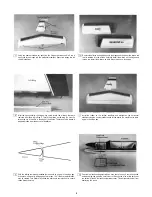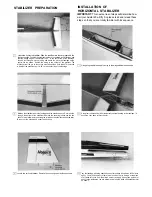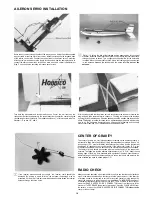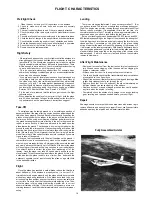
FLIGHT CHARACTERISTICS
Pre-Flight Check
1 Clean the dust dirt and oil off of the surface of the airplane
2 Check to make sure all nuts, bolts and screws are securely
fastened
3 Check all control surfaces to see if they are properly attached
4 Check the range of the radio system as the manufacturer recom-
mends
5 Check that all controls move smoothly and in the proper directions
6 Check the level of charge in the transmitter and receiver batteries
7 Check that the area being used is free of obstacles and debris
8 Check the frequencies currently in use at the field and in your area
9 Check the level of the fuel tank to be sure it is full
10 Double check the radio operation
Flight Safety
• If this airplane happens to be your first radio controlled airplane we
strongly suggest that you ask a skilled pilot or instructor to help you
learn how to fly You should also suggest to him to take the maiden
flight to see what problems (if any) that need to be worked out There
will be enough to worry about on your first solo flight without having
to worry about whether or not it is properly set up
• Fly in an open field without any obstructions For example trees
power lines buildings crowds of people etc are abstacles that the
plane may hit and cause damage
• If you are a novice pilot local area clubs have been formed and are
very willing to help you with any questions you may have Many of
the clubs even have club trainer airplanes that they will actually
teach you to fly with This helps prevent disappointing crashes on
your first flights Addresses of local area clubs can be located from
you local area hobby shop and/or by writing to Academy of Model
Aviation 1810 Samuel Morse Drive Reston VA 22090
• Fly the model at a reduced throttle until you get to know the flight
characteristics
• When adjusting the needle valve just prior to flight hold the plane
at a 45° nose up attitude full open throttle and adjust the throttle for
top performance as the manufacturer s instructions suggest
Take-Off
The airplane may be taxied around on a smooth/open section of
pavement without the wing after the engine has been adjusted and the
radio has been properly checked Become familiar with controlling the
plane on the ground with the rudder In the air you will find that most of
the time you will be using a combination of elevator and ailerons to turn
the plane because they are more effective in the air On the ground the
rudder is more effective A transition will need to be made once the
plane leaves the ground That transition from using the rudder on the
ground to using the ailerons once it leaves the ground will take a little
practice One good rule of thumb is to always take off directly into the
wind (if there is any) This will prevent the wind from trying to blow the
model from side to side and will not take as much runway as if you were
trying to take off downwind
Once you feel comfortable with the way it handles on the ground it
comes time for you to concentrate very much on the airplane s move
ments As you are ready for take off simply point the nose into the wind
and slowly advance the throttle up to full throttle At this point the plane
will be going very fast and will be very sensitive to your rudder inputs
Use smooth inputs to correct the plane from wandering off of the
runway Once the plane is at take off speed slowly pull back on the
elevator stick This will cause the plane to leave the ground At this point
notice whether the plane tends to turn climb or dive and make the
necessary opposite control inputs to keep the plane on a gentle climb
in the desired direction
Flight
Once the plane has reached a safe altitude reduce the throttle to
about half power If the airplane is properly set up (i e correct C G
trims all centered engine properly set) the plane should be very stable
without any wandering tendencies If the plane does tend to go one
direction more than another use your trim levers on your transmitter to
correct this Do not look at the transmitter while adjusting trims Then
while the plane is flying straight adjust the elevator trim to correct
abnormal climbing or diving If the trims will not overcome a turn or a
climbing tendency land the model immediately and check for improper
setup
Landing
There is an old saying that states You do not have to take off But
you do have to land Therefore be ready to land at all times during your
flight The engine may not stay running through a complete tank of fuel
for one reason or another It is suggested to time the run time of a
complete tank before flight That way you know approximately what to
expect and when you need to land before the fuel runs out
Set up your landing approach downwind at 100 200 feet up and 500
800 feet away depending on the height of the plane and the strength of
the wind Approach into the wind and slowly reduce the throttle to the
closed position Concentrate on the glide path of the plane taking
notice of whether the plane will reach the beginning of the runway or if
it will overshoot the runway completely With smooth deliberate inputs
use your engine power and your elevator to adjust the glide path so the
plane will touch down smoothly on the beginning of the runway at its
slowest speed It will still seem very fast and will use the complete
runway to slow down
After-Flight Maintenance
• Remove all excess fuel from the fuel tank as this fuel can become
jelly like and cause clogging of fuel lines as well as clogging the
engine s carburetor valves
• Always use after run oil in the engine to prevent corrosion
• Check and double check that the transmitter and receiver switches
are switched to the off positions
• Wipe off the excess oil that will collect on the wing and fuselage Use
a light duty cleanser to help cut through the oil
• Remove fresh fuel from the surface of the plane immediately as
different brands can cause clouding of the surface
• Replace any bent marred or dinged props as they can fly apart at
any time when the engine is running
• Completely check the airplane for damage to the wings landing
gear covering and repair as needed before your next flight
Repair
If damage should occur wipe the broken area clean with a clean rag to
remove all debris use epoxy glue to repair Do not use Cyanoacrylate
adhesive near any foam parts as it will deteriorate the foam
Fully Assembled Avistar
18
Summary of Contents for avistar 40
Page 20: ......

















